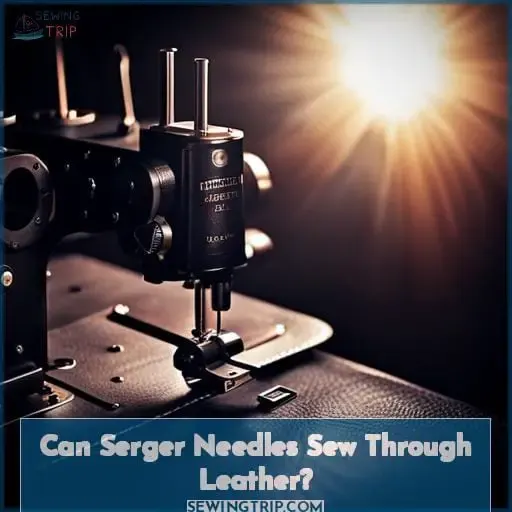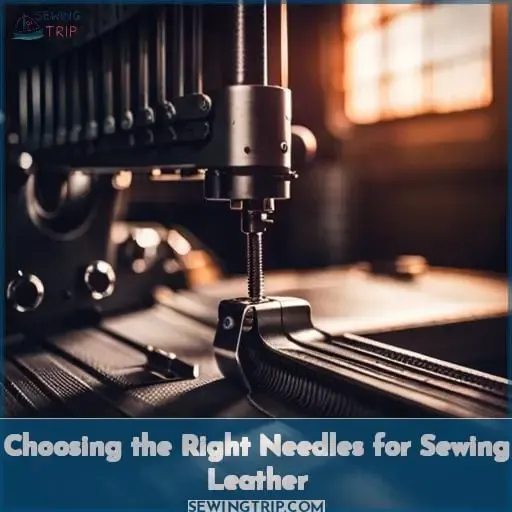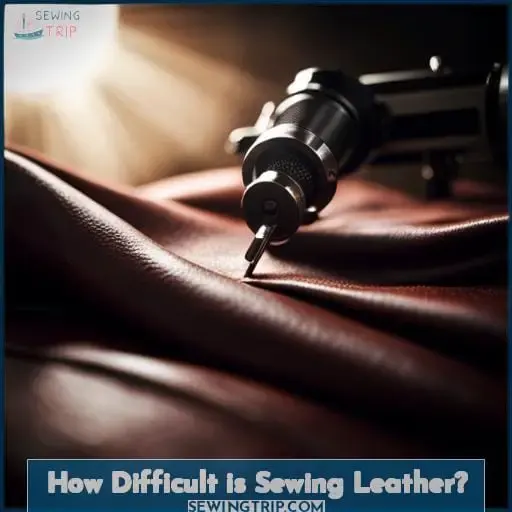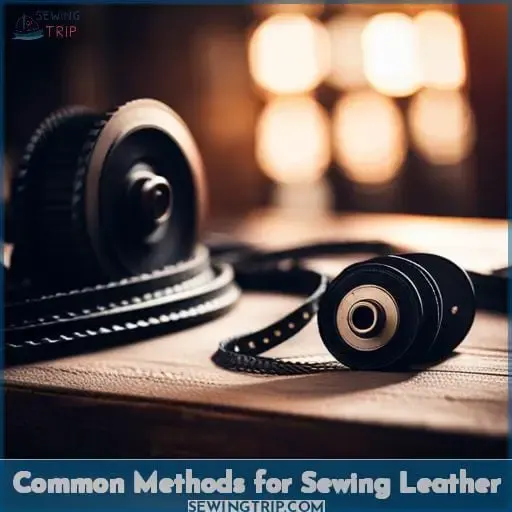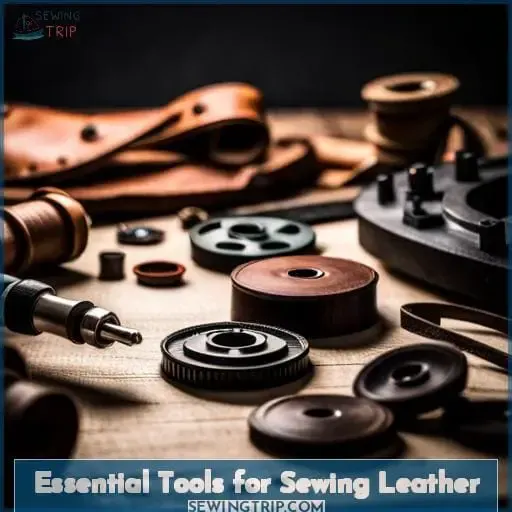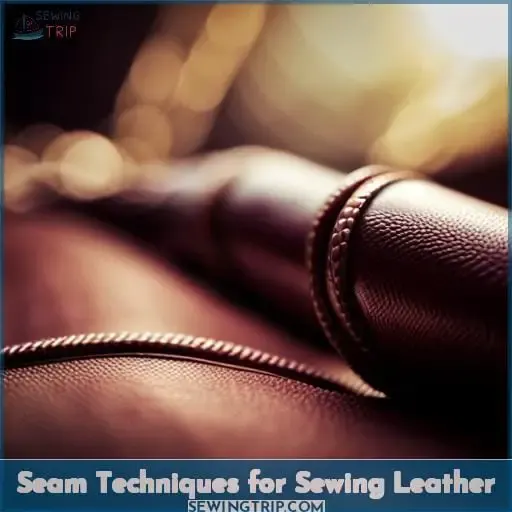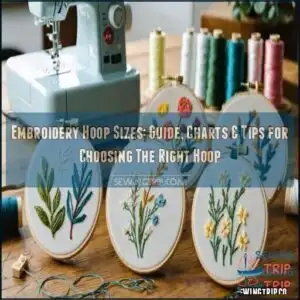This site is supported by our readers. We may earn a commission, at no cost to you, if you purchase through links.
 Are you ready to get your hands dirty and learn how to sew leather? It’s a difficult material that requires a special set of skills and tools, but if you follow the tips in this article, you’ll be able to create beautiful pieces with ease.
Are you ready to get your hands dirty and learn how to sew leather? It’s a difficult material that requires a special set of skills and tools, but if you follow the tips in this article, you’ll be able to create beautiful pieces with ease.
We’ll show you why sewing leather on a serger isn’t recommended, what materials it can handle, and which machines are best for the job.
So don’t wait any longer; let’s jump right into learning how to sew leather like an expert!
Table Of Contents
- Key Takeaways
- Sewing Leather on a Serger: Why It’s Not Recommended
- Can Serger Needles Sew Through Leather?
- What Materials Can a Serger Handle?
- Sewing Machines Vs Sergers: Which is Better for Sewing Leather?
- Choosing the Right Needles for Sewing Leather
- How Difficult is Sewing Leather?
- Common Methods for Sewing Leather
- Do I Need an Industrial Sewing Machine for Sewing Leather?
- Essential Tools for Sewing Leather
- Seam Techniques for Sewing Leather
- Frequently Asked Questions (FAQs)
- Conclusion
Key Takeaways
- Sewing leather on a serger is not recommended due to the difficulty and unsuitable needles.
- Specialty needles designed for leather sewing should be used.
- The stitch length should be kept long to reduce tension and resistance.
- Hand sewing or industrial machines are better options for sewing leather.
Sewing Leather on a Serger: Why It’s Not Recommended
Although it may be tempting to try, working with leather on a serger is not recommended due to its difficult nature and the inability of standard needles to handle thicker fabrics. Leather has a tendency to stretch as you sew, making it challenging for even experienced users.
Even when using specialty needles designed for leather sewing, stitch length should be kept long in order to reduce tension and resistance while avoiding backstitching or reinforcing stitches at all costs.
If you’re looking for an alternative method of stitching your leather projects together, then hand sewing or industrial machines are better options than a serger due to their ability to work with tougher materials more easily.
Although there are ways around this limitation, such as adjusting foot pedal pressure and disengaging blades when needed, ultimately no matter how advanced the tool is, there will still remain limitations that one must consider before embarking on any project involving thick fabric like leather!
Can Serger Needles Sew Through Leather?
Now that we know why sewing leather on a serger isn’t recommended, let’s answer the question of whether or not standard serger needles can sew through it. Unfortunately, the answer is no – regular needles are simply too thin and weak to handle thicker fabrics like leather.
However, certain higher quality machines may have specialty needles designed for heavier materials such as leather.
In order to get successful results when working with this material on a machine, you’ll need to make sure your tension settings are adjusted correctly and keep your stitch length longer than usual so that there’s less resistance while still avoiding backstitching altogether.
You should also consider using pressure foot tape or wonder clips if needed in order to help hold everything together more securely without creating holes from pins!
Lastly, remember: test runs on scraps before embarking on any project involving thick fabric and patience is key! It may take some time, but eventually, you’ll be able to masterfully create beautiful pieces out of leather with just the right amount of practice – and maybe even enjoy yourself along the way!
What Materials Can a Serger Handle?
Navigating the world of sergers can be daunting, but with a few tricks up your sleeve, you’ll soon find yourself masterfully finishing seams and creating beautiful pieces. Disengaging the blades, adjusting foot pedal pressure, and tension settings are all key components to success when working on thicker materials such as leather – which many people don’t expect their machine to handle! So if you’re looking for an extra challenge or want something unique in your wardrobe, try giving leather a go on your serger.
Disengaging the Blades
To work with thicker materials on a serger, you can try disengaging the blades to reduce resistance. Adjusting tension and foot pedal pressure is also important for better control of the fabric. Try using longer stitches when sewing leather or applying Scotch tape to the pressure foot for less friction.
Wonder clips can be used instead of pins and will help keep everything in place without creating holes in your material.
Adjusting Foot Pedal Pressure
You can adjust the foot pedal pressure on your serger to masterfully handle thicker fabrics, like leather, with ease. Select a sturdy needle that won’t break under intense tension and opt for a longer stitch length.
Consider using the tape technique or applying leather glue to avoid bunching up of fabric when sewing through thick layers. Properly adjusting the foot pedal tension gives you total control over the machine, allowing you to sew smoothly without any hiccups.
Adjusting Tension Settings
Fine-tuning the tension settings on your serger is essential for sewing heavier fabrics like leather. Manual tensioning allows you to increase pressure as needed, while specialty needles can cut through thick layers without breaking.
Test out different stitch lengths and tensions on a scrap of leather before starting your project. If necessary, add extra glue or Scotch tape to reduce resistance when passing through multiple layers of fabric.
Sewing Machines Vs Sergers: Which is Better for Sewing Leather?
Figuring out which machine is better for sewing leather can be tricky, but with the right knowledge, you’ll get that project done in no time. Sewing machines offer an advantage over sergers when it comes to working with this fabric as they are equipped to handle thicker materials and longer stitch lengths.
Specialty needles designed specifically for sewing leather will help ensure seamless stitching, while controlling tension levels is crucial. Leather glue can also be used if necessary – a great alternative if hand-stitching isn’t your thing! Industrial machines are another option; however, home sewers should keep in mind that these types of machines require more skill and precision than regular models do.
Choosing the Right Needles for Sewing Leather
Choosing the right needles is critical when tackling leather projects; selecting ones specifically designed for this fabric will transform your work into a masterpiece! Investing in quality needle sets that are sharp and strong enough to pierce through thick leather can make all the difference.
Besides needles, other items such as rotary cutters, binder clips, and leather glue are essential tools when sewing with this material. With these handy tools at hand, you’ll be able to achieve precise cuts without damaging any of your materials or stitching too fast before securing them properly together using techniques like backstitching or topstitching.
Leather cement can also help create clean finishes on seams while providing an extra layer of protection from fraying edges.
How Difficult is Sewing Leather?
Sewing leather can be daunting, but with the right know-how and tools, you’ll be ready to tackle any project! Here are some tips for working with this material:
- Get familiar with the supplies – Invest in quality needles that will pierce through thick leather and specialty tools such as rotary cutters and binder clips.
- Experiment on scraps – Before starting a project, it’s always best to practice sewing on small pieces of scrap first. This way, you can get a better idea of how your machine behaves when working with this fabric.
- Take your time – Leather is permanent, which means mistakes cannot easily be undone. So, take slow measured steps when piecing together projects or making adjustments during construction.
- Adjust tensions & stitch length – Sewing machines often need an adjustment in order for them to work properly while dealing with thicker materials like leather. Lengthening stitch lengths or reducing foot pressure should help keep the tension even without causing damage from excess friction.
With these simple tips, anyone can master sewing beautiful items made from luxurious-looking fabrics like suede or soft lambskin!
Common Methods for Sewing Leather
Leather is a versatile material that can be sewn by hand or with industrial machines. There are advantages and challenges to both methods; understanding them will help you decide which method best suits your project.
From traditional hand stitching to the efficiency of an automated machine, there is no wrong way to sew leather as long as it is done correctly.
Hand Sewing
For a more personalized touch, try hand-stitching your leather projects! You can create intricate designs that will last by using binder clips, rotary cutters, and quality needles made specifically for leather.
Start by securely attaching the pieces with glue designed for leather. Then, use a needle to slowly stitch together the two layers of fabric without backstitching or pulling too tightly on the thread. Make sure you don’t accidentally puncture any other parts of your project, as industrial machines do not have this issue.
If desired, add decorative stitching. It may seem harder than it actually is, so practice on scraps before attempting it on actual projects!
Industrial Machines
With industrial machines, you can create beautiful leather projects quickly and effortlessly.
- Choose the right thread type – polyester threads work best with leather due to their strength and durability.
- Match your sewing techniques – use a straight stitch or zigzag stitch on smoother pieces of leather, while more complicated patterns require an overlock or coverstitch.
- Balance out quality and price when selecting a machine – invest in good quality machinery that will last long-term but still be within budget.
- Consider different types of machines – flatbeds offer larger space for large-scale projects, while cylinder arms are great for creating tight curves on small items like wallets!
No matter which type of machine you choose, practice makes perfect! Test out different settings on scraps before starting any project—this way you’ll get familiar with how it handles various kinds of fabrics including thicker ones like leather without ruining them in the process.
Do I Need an Industrial Sewing Machine for Sewing Leather?
You can’t just grab any machine or tool when it comes to working with leather – knowledge and consideration of the tools available are essential. Sewing machines generally provide more control over stitch length, tension, and pressure than sergers do.
Industrial sewing machines often produce stronger stitches that are necessary for thick leather materials.
Advantages:
- Better quality stitching
Disadvantages:
- Expensive to purchase & maintain
- High-speed operation
- Not as precise as hand stitching
For smaller projects requiring intricate detail work, a regular home sewing machine may be suitable if you use specialized needles designed for leatherwork. Wonder clips can help hold your project in place without creating holes like pins would; scotch tape on the pressure foot is also recommended to reduce resistance while feeding thicker materials through the machine’s needle plate.
Longer stitch lengths should always be used when working with leather; this not only produces better results but also reduces strain on both fabric and thread during extended periods of use! Hand stitching still remains an option despite its tediousness but will require patience due to its permanent nature — especially since there is no room for error once sewn into place!
For larger scale projects where speed matters most, industrial machines offer heavy-duty construction along with powerful motors capable of handling even the toughest fabrics such as cowhide or suede at high speeds without sacrificing accuracy or strength in their stitches – all while using less energy compared to other methods! Leather glue may also come in handy depending upon your project’s needs so keep that in mind too if you don’t have access to an industrial-grade setup.
Either way, though, ultimately what works best depends upon how much time/money/effort one wishes to put into completing a specific task successfully given these constraints before starting out proper preparation beforehand required regardless of whether opting to go down the route from start to finish.
Essential Tools for Sewing Leather
When it comes to working with leather, having the right tools is essential. Binder clips can help hold projects in place without creating holes like pins would, while specialty needles designed for leatherwork should be used when sewing on a machine.
Leather glue or cement may also come in handy depending on your project’s needs, and a rotary cutter will make cutting through thick materials much easier! With careful preparation and the proper tools, you can create beautiful projects using leather that last for years to come.
Binder Clips
Binder clips can be a lifesaver when it comes to working with leather; as the saying goes, A stitch in time saves nine! They hold your project securely and without creating holes like pins do. Scotch tape on the pressure foot helps reduce tension and resistance, while longer stitch lengths are essential for better results.
Leather Needle
When working with leather, special needles made specifically for this material are essential – they create a strong and durable stitch.
- Leather glue for extra reinforcement;
- Choosing the right stitch lengths when sewing;
- Industrial machines offering heavy-duty construction that’s perfect for thick materials like cowhide or suede;
- Wonder clips to hold your project without creating holes as pins do, plus leather cement to secure it in place afterward! No matter what tools you choose, patience and preparation are key when sewing with this often difficult fabric – take time to test runs on scraps before starting any project!
Leather Glue/Cement
Secure your leather project with confidence using specialized glue or cement for extra reinforcement. Choose from the various types of leather glues available that offer different levels of adhesion and flexibility.
Avoid creases in hide thicknesses by applying an even layer across all edges before stitching, as this will help ensure strength and stability. Edge finishing is made easier when using specialized glue – it won’t seep into stitches, creating hard-to-remove ridges or bubbles on the surface of the material.
Rotary Cutter
A rotary cutter can be a great tool when working with leather. Quickly and accurately cut through multiple layers without fraying the edges to create precise shapes and lines. Pick up some supplies: leather glue, longer stitches, Scotch tape for the pressure foot, specialty needles for seam techniques.
Seam Techniques for Sewing Leather
To craft beautiful leather projects that last, it’s important to understand the proper techniques for sewing. Weaving stitches can be used to sew two pieces of leather together, while edge finishing methods like basting stitch and whipstitching provide a polished look.
Specialty needles specifically designed for working with thicker materials are recommended when sewing on a machine, along with marking tools such as chalk or water-soluble pens. The tension settings should also be adjusted accordingly depending on the thickness of the material you’re working with.
Working slowly and without backstitching is essential too – this will help ensure your seams stay secure without damaging them in any way! Patience and practice go hand in hand when creating perfect projects from leather; taking time to test out different stitching techniques before starting your project can make all the difference!
Frequently Asked Questions (FAQs)
What are the best practices for sewing leather on a machine?
Sewing leather on a machine requires patience and preparation. Use special needles, make long stitches, and reduce pressure with Scotch tape or wonder clips.
How can I prevent damage to the leather while sewing?
Sewing leather can be tricky. To prevent damage, use specialized needles, clip fabric in place with Wonder clips instead of piercing it, and reduce tension by applying Scotch tape to the pressure foot.
Sew slowly without backstitching and test run on scraps for best results! Liberate yourself from sewing stress with patience and preparation.
Is it possible to sew leather on a serger without disengaging the blades?
Yes, you can sew leather on a serger – but it’s tricky. Disengaging the blades might help; adjust the foot pedal pressure and tension settings too. Use specialized needles and go slow – no backstitching! Test runs with scrap leather are essential for success.
Are there any alternatives to sewing leather on a machine?
You can try hand-sewing or using an industrial machine for leather projects. Both offer more control and precision than a serger, so you’ll be able to create professional results with ease.
What types of leather are the easiest to sew?
Soft leathers, such as lambskin or deerskin, are the easiest to sew. Choose needles designed for heavyweight fabrics and adjust foot pressure and tension settings for added control.
Conclusion
In conclusion, sewing leather with a serger is not recommended. While higher-quality sergers can handle thicker materials, they are still not ideal for leather due to the difficulty of the material. For this reason, it’s best to use a sewing machine with specialized needles for leather.
Sewing leather is a process that requires patience and preparation, and it’s important to choose the right tools and techniques to ensure success.


